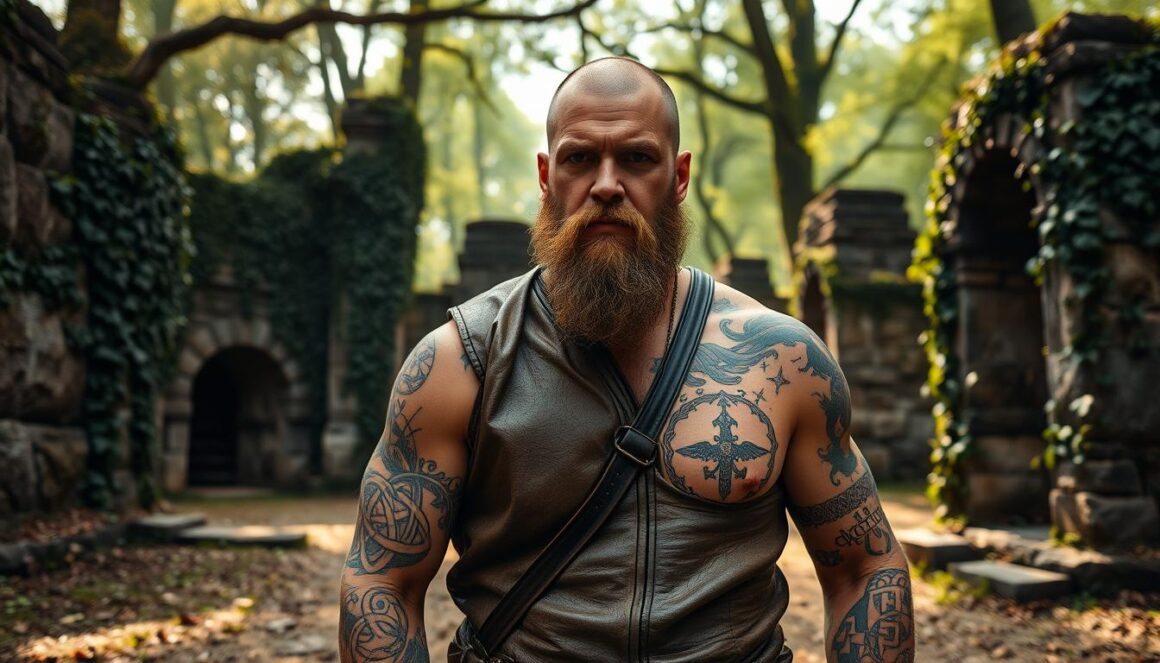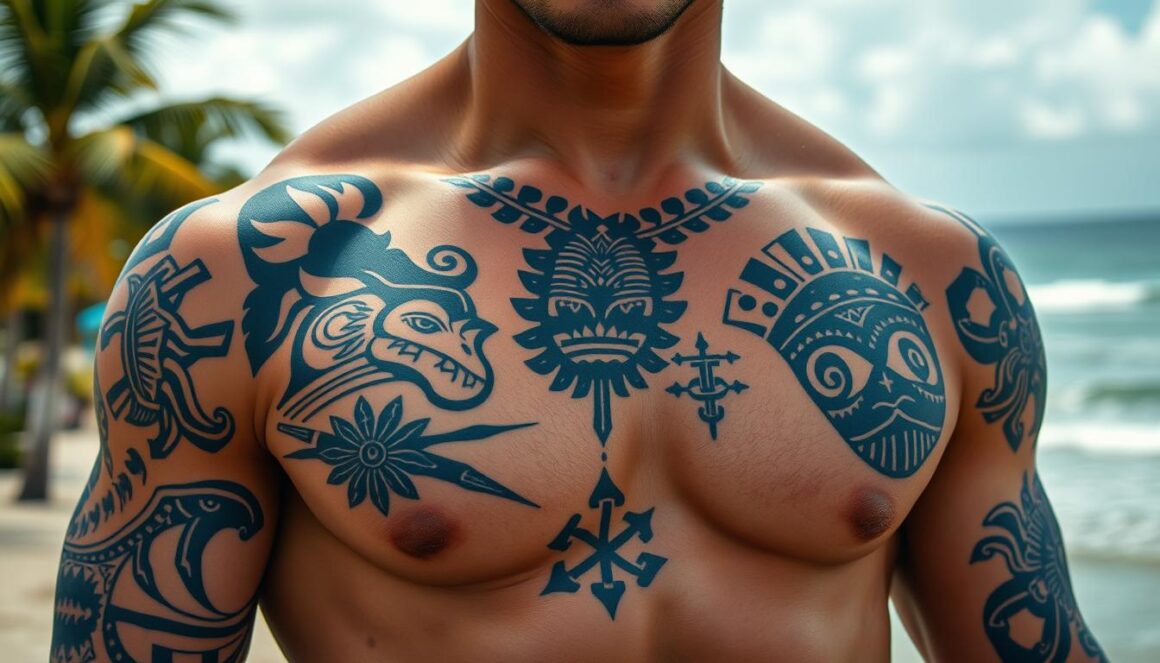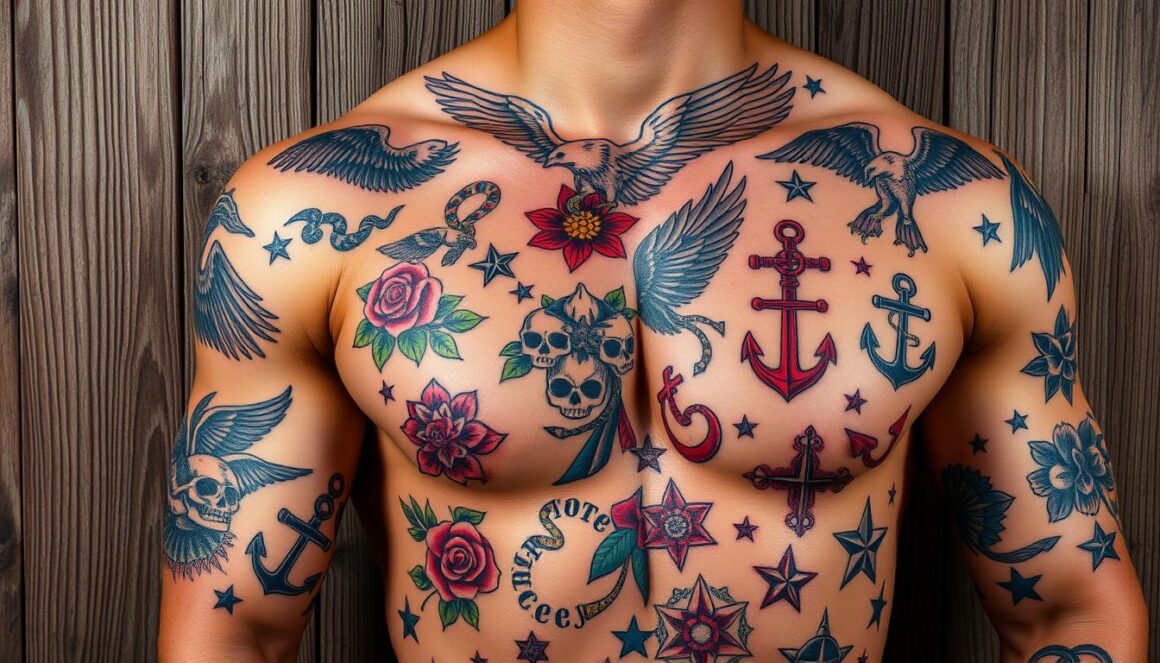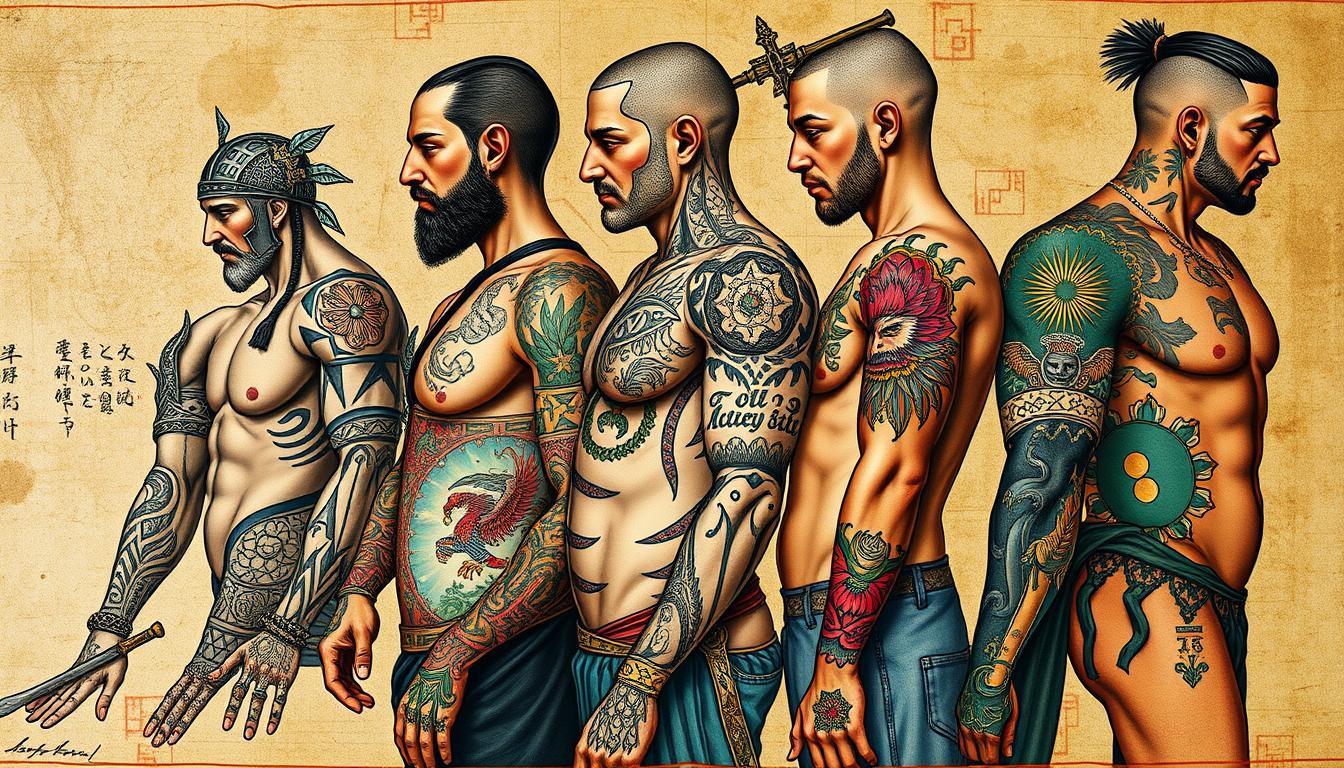Imagine a rugged sailor with tattoos that tell his sea stories. Or a tribal chief with symbols that show his power. Tattoos have been a part of human culture for thousands of years. They are a canvas for self-expression, spiritual connection, and cultural identity.
From ancient Egyptians to Polynesian islanders, the history of tattoos on men is fascinating. It shows how this timeless art has evolved over time.
Key Takeaways
- Tattoos have a history dating back over 5,300 years, with evidence found in ancient civilizations like Egypt and Polynesia.
- The term “tattoo” likely derives from Polynesian words meaning “to mark” or “to puncture.”
- Tattoos have been used for a variety of purposes, including spiritual protection, social status, and medical treatment.
- The practice of tattooing spread globally through exploration and cultural exchange, with Captain James Cook’s voyages in the 18th century introducing tattoos to Western society.
- Tattoos have evolved from tribal markings to modern art forms, reflecting changing cultural attitudes and technological advancements.
Ancient Tribal Markings and Tattoos
Tattoos have a long history, dating back thousands of years. Ancient tribal cultures worldwide used tattoos as part of their cultural practices. Ötzi, the Iceman, had 61 tattoos believed to have healing powers. Egyptian mummies also had intricate designs, showing tattoos’ importance in self-expression and identity.
In the Polynesian islands, “tatau” tattoos have been a key part of culture for over 1,000 years. They symbolize strength, courage, and protection. The Maori people of New Zealand have “moko” tattoos that connect personal and community identity. Native American cultures used tattoos to honor heritage and connect with the spiritual world.
In ancient Egypt, Greece, and Rome, tattoos marked identity, religious beliefs, and social status. The oldest known tattoos were found on Egyptian mummies, dating back to around 3,000 BCE. Amunet, a priestess of Hathor, is one of the earliest known individuals with tattoos, from about 2,100 BCE.
Today, the cultural significance of these tattoos is often misunderstood or taken out of context. Yet, they are still a powerful symbol of identity, heritage, and spiritual connection for many indigenous communities worldwide.
Tattoos in Medieval and Renaissance Europe

The history of tattoos in medieval and Renaissance Europe is quite interesting. Initially, Greek and Roman cultures saw tattoos as bad, using them for criminals and slaves. But, tattoos kept showing up in different ways over time.
In 306-337 CE, Roman Emperor Constantine banned tattoos because of religious reasons. Yet, tattoos didn’t disappear. They were still important in medieval and Renaissance Europe, linked to outcasts and the marginalized. Despite the negative views, tattoos played a big role in European history.
The 18th century saw tattoos come back to Europe, thanks to Captain James Cook’s travels. His journeys to the South Pacific introduced Europeans to Polynesian tattoo traditions. This sparked a love for “exotic” tattoos, leading to tattoo parlors and the spread of traditional designs.
Today, tattoos from medieval and Renaissance times still influence artists and fans. They use old symbolism and cultural meanings to make their own designs. From Timmy Grounds’ detailed black and grey work to the “trash polka” style, tattooing has grown. But its European roots are still a big part of its story.
Pacific Islander Traditions and Tattoos

Polynesian tattoos have a long history, over 2,000 years old. They carry deep meaning for Pacific island communities. Each culture has its own tattoo traditions.
For example, Samoan pe’a tattoos were key for leaders. Maori moko tattoos in New Zealand shared personal info. These tattoos are unique to each culture.
The history of Polynesian tattoos started 3,000 years ago. Each culture had its own designs. Tongan warriors wore geometric patterns, while Samoan women had floral motifs.
Marquesan tattoos, from around 200 CE, covered the body in detailed designs. These tattoos were a big part of their culture.
Tattooing in Polynesia was tied to traditions and beliefs. The tools, like combs made from teeth, have stayed the same for generations. The process was tough, taking up to a year to heal.
Today, Polynesian tattoos are making a comeback. People want to connect with their heritage. Traditional tattooists focus on unique designs, taking years to create.
As Tahiarii Yoram Pariente says, “our tattoos took three years to create. We found the right artist and added personal meaning.”
Tattoos in 19th Century America

In the 19th century, tattoos in America changed a lot. They were once seen as taboo and for working-class men. But, they started to become popular in different groups. This change came from new technology and the influence of sailors.
In 1870, Martin Hildebrandt opened the first tattoo shop in the U.S. in New York City. This was a big step for tattoo culture in America. Then, in 1891, Samuel O’Reilly made the electric tattoo machine. This made tattoos easier and cheaper for everyone.
American sailors and sailors’ communities had tattoos since the start of the country. Soldiers and sailors coming back from abroad brought new tattoo styles. These tattoos showed courage, patriotism, and personal style.
Traveling circuses and tattooed performers like Frank and Emma DeBurdg also helped tattoos become more popular. By the end of the century, tattoos were becoming a common way to express oneself.
Even though tattoos were getting more accepted, the rich still didn’t like them. Ward McAllister, for example, didn’t approve of tattoos. But, people like Lady Randolph Churchill, Winston Churchill’s mom, loved tattoos and got them.
The 19th century was a big change for tattoos in America. It led to the rise of traditional American tattoo styles and the tattoo boom of the 20th century.
Post-World War Tattoo Boom
After World War II, tattoos became very popular. Before the war, many young men got tattoos as they prepared to serve. When they returned, almost all had tattoos, often to show their unit or rank.
This was the start of the tattoo renaissance. Artists like Sailor Jerry in Hawaii led the way. His designs appealed to many, helping create a lively tattoo culture.
But tattoos also had a dark side. In Nazi Germany, they were used to control and dehumanize people. Yet, tattoos can help veterans heal, as seen in programs like Operation Tattooing Freedom.
As the 20th century went on, tattoos became more accepted. Reality TV and new styles, like watercolor tattoos, helped. This made tattoos a part of modern society.
Modern Expressions and Tattoo Trends
The 21st century has seen a burst of creativity in tattoos. Tattoo artists are now creating innovative designs that show off their skills. They make everything from realistic portraits to stunning geometric patterns.
Watercolor tattoos are very popular now. They have a soft, dreamy look that people love. Artists are also mixing different styles, like realism with abstract, to show their creativity.
Tattoos are now seen as a way to express oneself. Celebrities like Angelina Jolie and David Beckham have helped make tattoos more popular. They inspire people to get tattoos to mark important moments or share their stories.
The future of tattoos looks bright with new tech coming in. Things like 3D printing for tattoo machines and augmented reality for designs are exciting. These advancements will keep inspiring both artists and fans of tattoos.
Wrapping up
The history of tattoos on men is long and rich. It spans thousands of years, filled with cultural significance and personal stories. From ancient tribal marks to Polynesian designs, tattoos have traveled far and wide. They have overcome stigma to become a big part of today’s culture.
Tattoos have always meant something special. They show spiritual beliefs, social standing, and personal identity. They reflect the depth of human experiences across different times and places. As tattoo art grows, it keeps being a strong way to share thoughts, explore oneself, and honor heritage and beliefs.
Looking ahead, tattoos will likely see new tech, methods, and styles. This will keep the art of tattooing exciting and inspiring for everyone. Tattoos will continue to show our strength, identity, and the power of self-expression. They will remain a key part of our cultural fabric, shaping our world.



